Penny Karanasou
Speak & Improve Challenge 2025: Tasks and Baseline Systems
Dec 17, 2024Abstract:This paper presents the "Speak & Improve Challenge 2025: Spoken Language Assessment and Feedback" -- a challenge associated with the ISCA SLaTE 2025 Workshop. The goal of the challenge is to advance research on spoken language assessment and feedback, with tasks associated with both the underlying technology and language learning feedback. Linked with the challenge, the Speak & Improve (S&I) Corpus 2025 is being pre-released, a dataset of L2 learner English data with holistic scores and language error annotation, collected from open (spontaneous) speaking tests on the Speak & Improve learning platform. The corpus consists of approximately 315 hours of audio data from second language English learners with holistic scores, and a 55-hour subset with manual transcriptions and error labels. The Challenge has four shared tasks: Automatic Speech Recognition (ASR), Spoken Language Assessment (SLA), Spoken Grammatical Error Correction (SGEC), and Spoken Grammatical Error Correction Feedback (SGECF). Each of these tasks has a closed track where a predetermined set of models and data sources are allowed to be used, and an open track where any public resource may be used. Challenge participants may do one or more of the tasks. This paper describes the challenge, the S&I Corpus 2025, and the baseline systems released for the Challenge.
A Comparative Analysis of Pretrained Language Models for Text-to-Speech
Sep 04, 2023Abstract:State-of-the-art text-to-speech (TTS) systems have utilized pretrained language models (PLMs) to enhance prosody and create more natural-sounding speech. However, while PLMs have been extensively researched for natural language understanding (NLU), their impact on TTS has been overlooked. In this study, we aim to address this gap by conducting a comparative analysis of different PLMs for two TTS tasks: prosody prediction and pause prediction. Firstly, we trained a prosody prediction model using 15 different PLMs. Our findings revealed a logarithmic relationship between model size and quality, as well as significant performance differences between neutral and expressive prosody. Secondly, we employed PLMs for pause prediction and found that the task was less sensitive to small models. We also identified a strong correlation between our empirical results and the GLUE scores obtained for these language models. To the best of our knowledge, this is the first study of its kind to investigate the impact of different PLMs on TTS.
Controllable Emphasis with zero data for text-to-speech
Jul 13, 2023Abstract:We present a scalable method to produce high quality emphasis for text-to-speech (TTS) that does not require recordings or annotations. Many TTS models include a phoneme duration model. A simple but effective method to achieve emphasized speech consists in increasing the predicted duration of the emphasised word. We show that this is significantly better than spectrogram modification techniques improving naturalness by $7.3\%$ and correct testers' identification of the emphasized word in a sentence by $40\%$ on a reference female en-US voice. We show that this technique significantly closes the gap to methods that require explicit recordings. The method proved to be scalable and preferred in all four languages tested (English, Spanish, Italian, German), for different voices and multiple speaking styles.
eCat: An End-to-End Model for Multi-Speaker TTS & Many-to-Many Fine-Grained Prosody Transfer
Jun 20, 2023Abstract:We present eCat, a novel end-to-end multispeaker model capable of: a) generating long-context speech with expressive and contextually appropriate prosody, and b) performing fine-grained prosody transfer between any pair of seen speakers. eCat is trained using a two-stage training approach. In Stage I, the model learns speaker-independent word-level prosody representations in an end-to-end fashion from speech. In Stage II, we learn to predict the prosody representations using the contextual information available in text. We compare eCat to CopyCat2, a model capable of both fine-grained prosody transfer (FPT) and multi-speaker TTS. We show that eCat statistically significantly reduces the gap in naturalness between CopyCat2 and human recordings by an average of 46.7% across 2 languages, 3 locales, and 7 speakers, along with better target-speaker similarity in FPT. We also compare eCat to VITS, and show a statistically significant preference.
Simple and Effective Multi-sentence TTS with Expressive and Coherent Prosody
Jun 29, 2022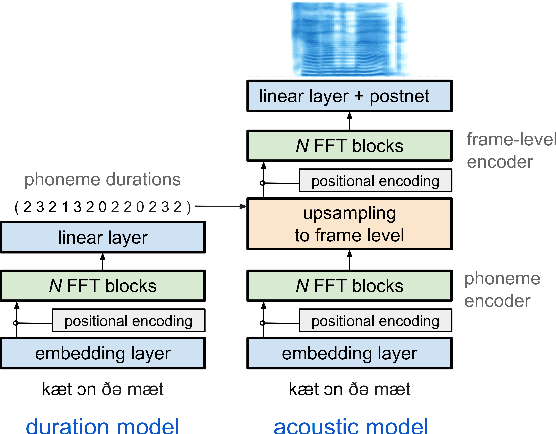
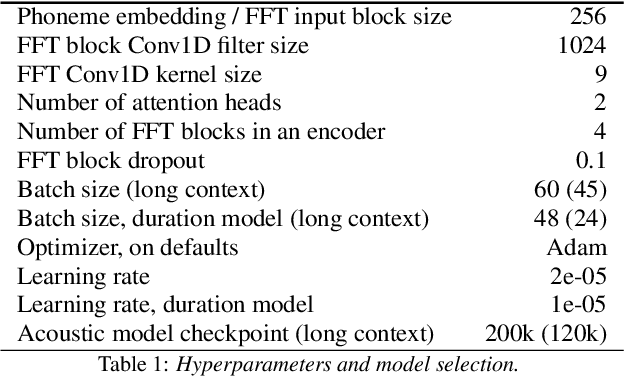

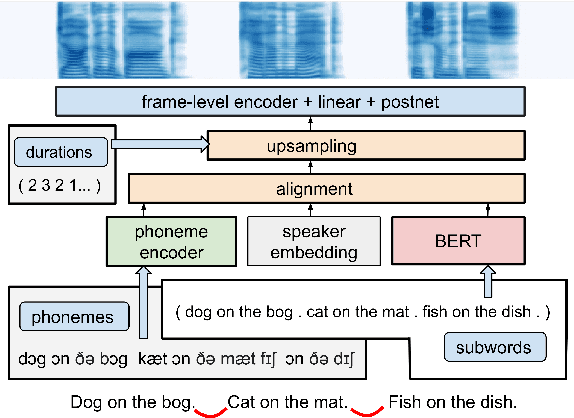
Abstract:Generating expressive and contextually appropriate prosody remains a challenge for modern text-to-speech (TTS) systems. This is particularly evident for long, multi-sentence inputs. In this paper, we examine simple extensions to a Transformer-based FastSpeech-like system, with the goal of improving prosody for multi-sentence TTS. We find that long context, powerful text features, and training on multi-speaker data all improve prosody. More interestingly, they result in synergies. Long context disambiguates prosody, improves coherence, and plays to the strengths of Transformers. Fine-tuning word-level features from a powerful language model, such as BERT, appears to profit from more training data, readily available in a multi-speaker setting. We look into objective metrics on pausing and pacing and perform thorough subjective evaluations for speech naturalness. Our main system, which incorporates all the extensions, achieves consistently strong results, including statistically significant improvements in speech naturalness over all its competitors.
CopyCat2: A Single Model for Multi-Speaker TTS and Many-to-Many Fine-Grained Prosody Transfer
Jun 27, 2022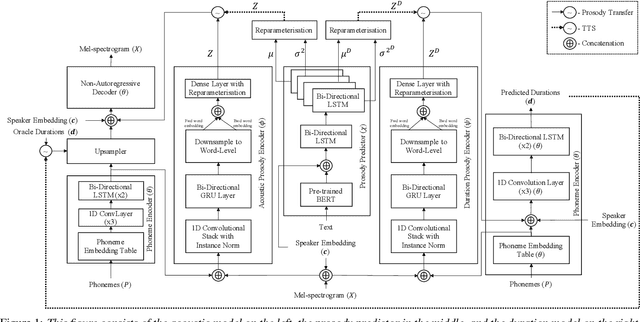

Abstract:In this paper, we present CopyCat2 (CC2), a novel model capable of: a) synthesizing speech with different speaker identities, b) generating speech with expressive and contextually appropriate prosody, and c) transferring prosody at fine-grained level between any pair of seen speakers. We do this by activating distinct parts of the network for different tasks. We train our model using a novel approach to two-stage training. In Stage I, the model learns speaker-independent word-level prosody representations from speech which it uses for many-to-many fine-grained prosody transfer. In Stage II, we learn to predict these prosody representations using the contextual information available in text, thereby, enabling multi-speaker TTS with contextually appropriate prosody. We compare CC2 to two strong baselines, one in TTS with contextually appropriate prosody, and one in fine-grained prosody transfer. CC2 reduces the gap in naturalness between our baseline and copy-synthesised speech by $22.79\%$. In fine-grained prosody transfer evaluations, it obtains a relative improvement of $33.15\%$ in target speaker similarity.
Multi-Scale Spectrogram Modelling for Neural Text-to-Speech
Jun 29, 2021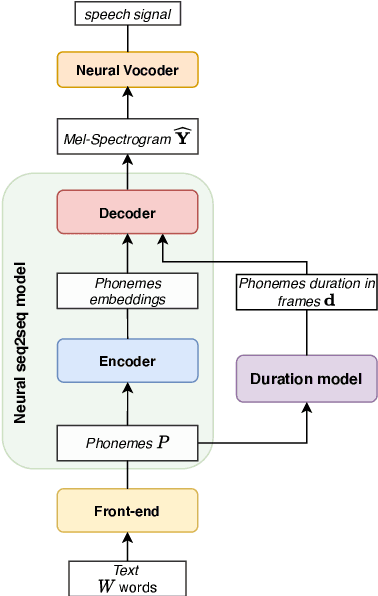
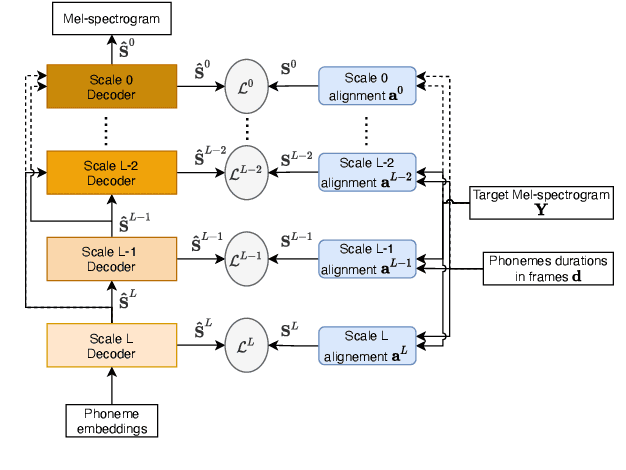
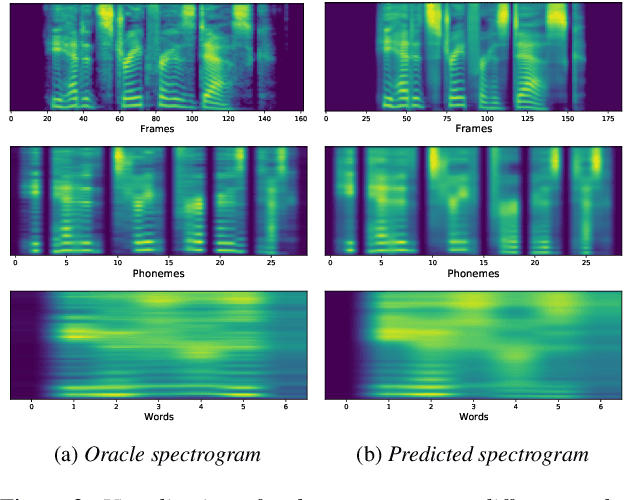
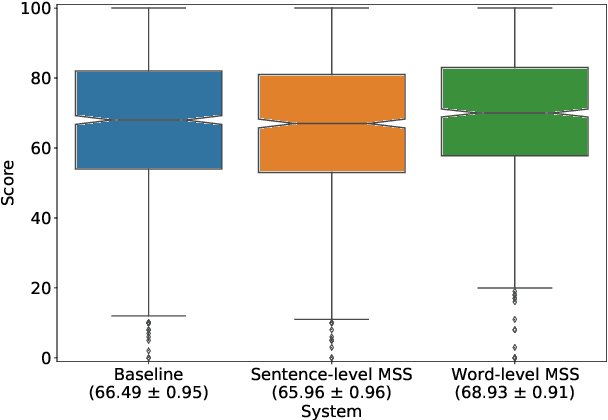
Abstract:We propose a novel Multi-Scale Spectrogram (MSS) modelling approach to synthesise speech with an improved coarse and fine-grained prosody. We present a generic multi-scale spectrogram prediction mechanism where the system first predicts coarser scale mel-spectrograms that capture the suprasegmental information in speech, and later uses these coarser scale mel-spectrograms to predict finer scale mel-spectrograms capturing fine-grained prosody. We present details for two specific versions of MSS called Word-level MSS and Sentence-level MSS where the scales in our system are motivated by the linguistic units. The Word-level MSS models word, phoneme, and frame-level spectrograms while Sentence-level MSS models sentence-level spectrogram in addition. Subjective evaluations show that Word-level MSS performs statistically significantly better compared to the baseline on two voices.
A learned conditional prior for the VAE acoustic space of a TTS system
Jun 14, 2021
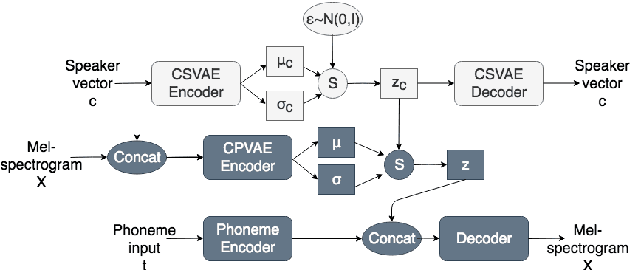


Abstract:Many factors influence speech yielding different renditions of a given sentence. Generative models, such as variational autoencoders (VAEs), capture this variability and allow multiple renditions of the same sentence via sampling. The degree of prosodic variability depends heavily on the prior that is used when sampling. In this paper, we propose a novel method to compute an informative prior for the VAE latent space of a neural text-to-speech (TTS) system. By doing so, we aim to sample with more prosodic variability, while gaining controllability over the latent space's structure. By using as prior the posterior distribution of a secondary VAE, which we condition on a speaker vector, we can sample from the primary VAE taking explicitly the conditioning into account and resulting in samples from a specific region of the latent space for each condition (i.e. speaker). A formal preference test demonstrates significant preference of the proposed approach over standard Conditional VAE. We also provide visualisations of the latent space where well-separated condition-specific clusters appear, as well as ablation studies to better understand the behaviour of the system.
Prosodic Representation Learning and Contextual Sampling for Neural Text-to-Speech
Nov 04, 2020
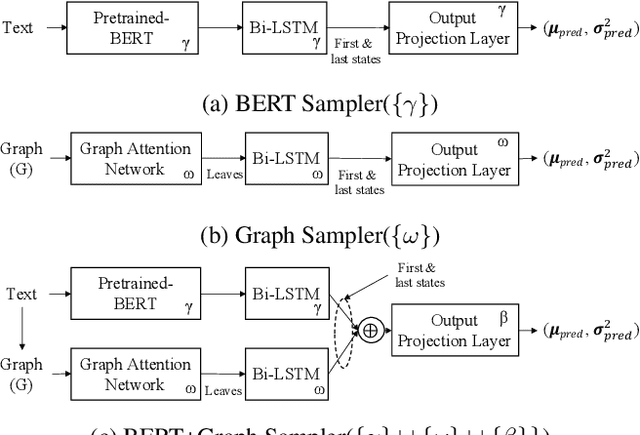
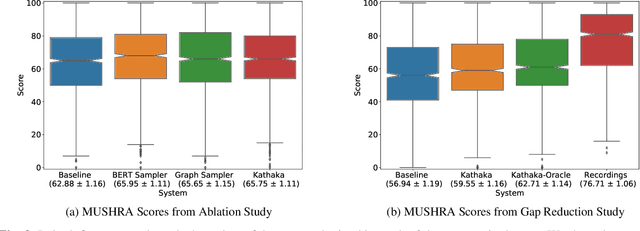
Abstract:In this paper, we introduce Kathaka, a model trained with a novel two-stage training process for neural speech synthesis with contextually appropriate prosody. In Stage I, we learn a prosodic distribution at the sentence level from mel-spectrograms available during training. In Stage II, we propose a novel method to sample from this learnt prosodic distribution using the contextual information available in text. To do this, we use BERT on text, and graph-attention networks on parse trees extracted from text. We show a statistically significant relative improvement of $13.2\%$ in naturalness over a strong baseline when compared to recordings. We also conduct an ablation study on variations of our sampling technique, and show a statistically significant improvement over the baseline in each case.
Selecting Machine-Translated Data for Quick Bootstrapping of a Natural Language Understanding System
May 23, 2018
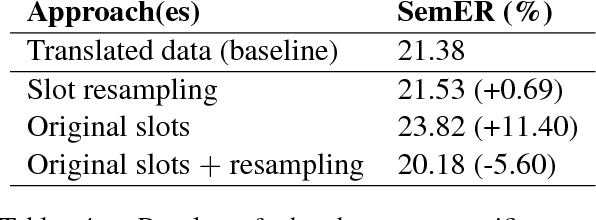
Abstract:This paper investigates the use of Machine Translation (MT) to bootstrap a Natural Language Understanding (NLU) system for a new language for the use case of a large-scale voice-controlled device. The goal is to decrease the cost and time needed to get an annotated corpus for the new language, while still having a large enough coverage of user requests. Different methods of filtering MT data in order to keep utterances that improve NLU performance and language-specific post-processing methods are investigated. These methods are tested in a large-scale NLU task with translating around 10 millions training utterances from English to German. The results show a large improvement for using MT data over a grammar-based and over an in-house data collection baseline, while reducing the manual effort greatly. Both filtering and post-processing approaches improve results further.
 Add to Chrome
Add to Chrome Add to Firefox
Add to Firefox Add to Edge
Add to Edge